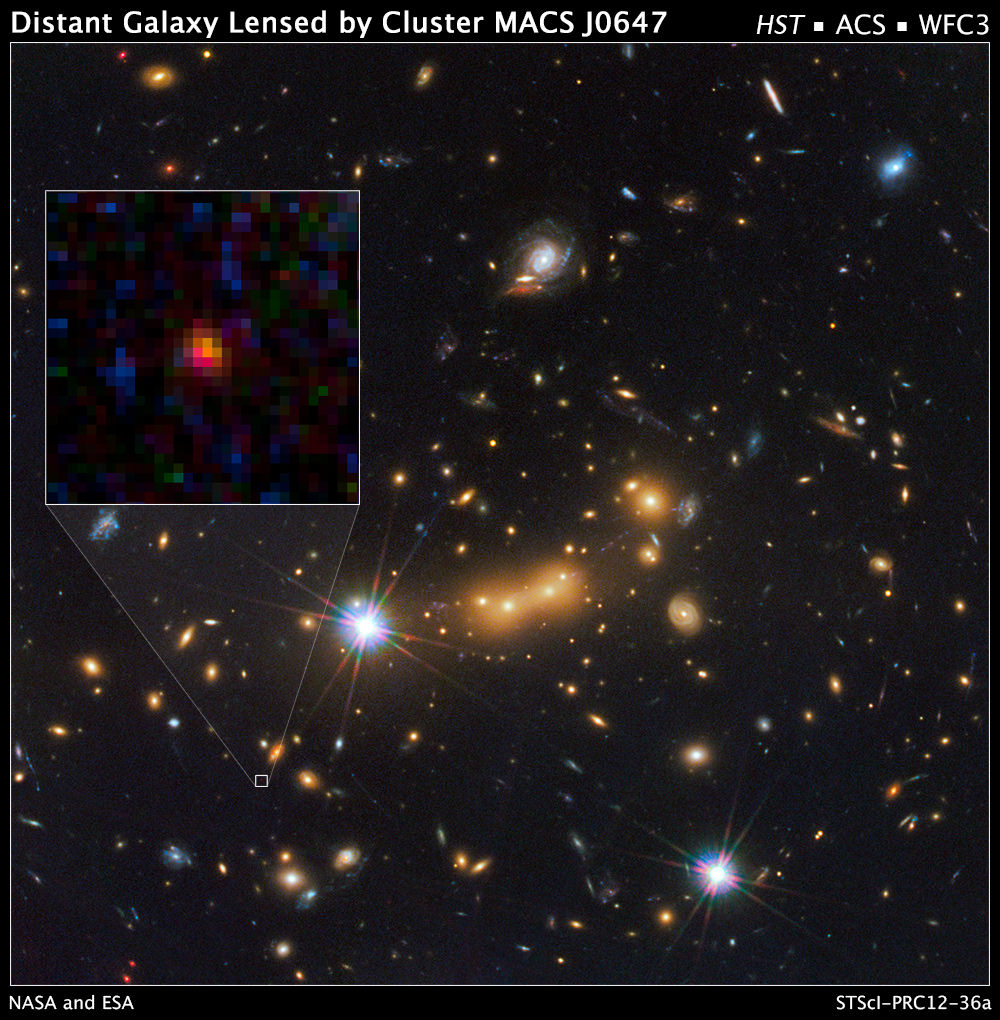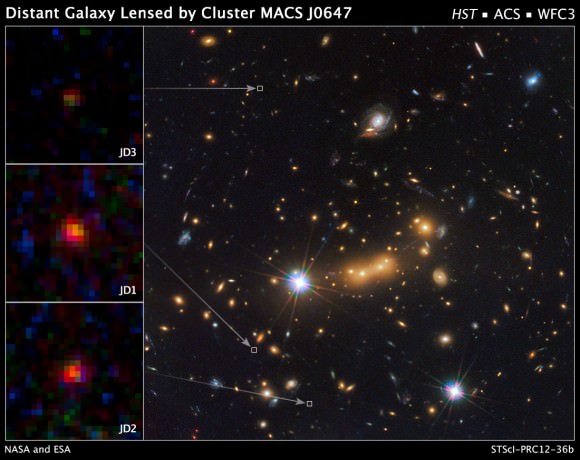It seems that every few months or so comes a new discovery of a new “most distant galaxy ever found.” It’s not really a surprise that new benchmarks are reached with such an amazing frequency as our telescopes get better and astronomers refine their techniques for observing faraway and ancient objects. This latest “most distant” is pretty interesting in that it was found by combining observations from two space telescopes – Hubble and Spitzer – as well as using massive galaxy clusters as gravitational lenses to magnify the distant galaxy behind them. It’s also extremely small and may not even be a fully developed galaxy at the time we are seeing it.
While this galaxy, named MACS0647-JD, appears as a diminutive blob in the new images, astronomers say it offers a peek back into a time when the universe was just 3 percent of its present age of 13.7 billion years. This newly discovered galaxy was observed 420 million years after the Big Bang, and its light has traveled 13.3 billion years to reach Earth.
“This object may be one of many building blocks of a galaxy,” said Dan Coe of the Space Telescope Science Institute, lead author of a new paper on the observations. “Over the next 13 billion years, it may have dozens, hundreds, or even thousands of merging events with other galaxies and galaxy fragments.”
The discovery comes from the Cluster Lensing And Supernova Survey with Hubble (CLASH), a program that combines the power of space telescopes with the natural zoom of gravitational lensing to reveal distant galaxies in the early Universe. Observations with Spitzer’s infrared eyes allowed for confirmation of this object.
The light from MACS0647-JD was magnified by a massive galaxy cluster named MACS J0647+7015, and without the cluster’s magnification powers, astronomers would not have seen the remote galaxy. Because of gravitational lensing, the CLASH research team was able to observe three magnified images of MACS0647-JD with the Hubble telescope. The cluster’s gravity boosted the light from the faraway galaxy, making the images appear about eight, seven, and two times brighter than they otherwise would that enabled astronomers to detect the galaxy more efficiently and with greater confidence.
“This cluster does what no manmade telescope can do,” said Marc Postman, also from STScI. “Without the magnification, it would require a Herculean effort to observe this galaxy.”
MACS0647-JD is just a fraction of the size of our Milky Way galaxy, and is so small it may not even be a fully formed galaxy. Data show the galaxy is less than 600 light-years wide. Based on observations of somewhat closer galaxies, astronomers estimate that a typical galaxy of a similar age should be about 2,000 light-years wide. For comparison, the Large Magellanic Cloud, a dwarf galaxy companion to the Milky Way, is 14,000 light-years wide. Our Milky Way is 150,000 light-years across.
The galaxy was observed with 17 filters, spanning near-ultraviolet to near-infrared wavelengths, using Hubble’s Wide Field Camera 3 (WFC3) and Advanced Camera for Surveys (ACS). Coe discovered the galaxy in February while poring over a catalogue of thousands of gravitationally lensed objects found in Hubble observations of 17 clusters in the CLASH survey. But the galaxy appeared only in the two reddest filters.
“So either MACS0647-JD is a very red object, only shining at red wavelengths, or it is extremely distant and its light has been ‘redshifted’ to these wavelengths, or some combination of the two,” Coe said. “We considered this full range of possibilities.”
The CLASH team identified multiple images of eight galaxies lensed by the galaxy cluster. Their positions allowed the team to produce a map of the cluster’s mass, which is primarily composed of dark matter. Dark matter is an invisible form of matter that makes up the bulk of the universe’s mass. “It’s like a big puzzle,” said Coe. “We have to arrange the mass in the cluster so that it deflects the light of each galaxy to the positions observed.” The team’s analysis revealed that the cluster’s mass distribution produced three lensed images of MACS0647-JD at the positions and relative brightness observed in the Hubble image.
Coe and his collaborators spent months systematically ruling out these other alternative explanations for the object’s identity, including red stars, brown dwarfs, and red (old or dusty) galaxies at intermediate distances from Earth. They concluded that a very distant galaxy was the correct explanation.
Redshift is a consequence of the expansion of space over cosmic time. Astronomers study the distant universe in near-infrared light because the expansion of space stretches ultraviolet and visible light from galaxies into infrared wavelengths. Coe estimates MACS0647-JD has a redshift of 11, the highest yet observed.
Images of the galaxy at longer wavelengths obtained with the Spitzer Space Telescope played a key role in the analysis. If the object were intrinsically red, it would appear bright in the Spitzer images. Instead, the galaxy barely was detected, if at all, indicating its great distance. The research team plans to use Spitzer to obtain deeper observations of the galaxy, which should yield confident detections as well as estimates of the object’s age and dust content.
MACS0647-JD galaxy, however, may be too far away for any current telescope to confirm the distance based on spectroscopy, which spreads out an object’s light into thousands of colors. Nevertheless, Coe is confident the fledgling galaxy is the new distance champion based on its unique colors and the research team’s extensive analysis. “All three of the lensed galaxy images match fairly well and are in positions you would expect for a galaxy at that remote distance when you look at the predictions from our best lens models for this cluster,” Coe said.
The new distance champion is the second remote galaxy uncovered in the CLASH survey, a multi-wavelength census of 25 hefty galaxy clusters with Hubble’s ACS and WFC3. Earlier this year, the CLASH team announced the discovery of a galaxy that existed when the universe was 490 million years old, 70 million years later than the new record-breaking galaxy. So far, the survey has completed observations for 20 of the 25 clusters.
The team hopes to use Hubble to search for more dwarf galaxies at these early epochs. If these infant galaxies are numerous, then they could have provided the energy to burn off the fog of hydrogen that blanketed the universe, a process called re-ionization. Re-ionization ultimately made the universe transparent to light.
Sources: HubbleSite, ESA Hubble



Four words come to mind here: James Webb Space Telescope!
Sci Fi short story subject: The James Webb S.T. comes on line.. With it we see distinct similarities in distant and ‘lensed’ galaxies which leave no doubt they resemble molecular structures. Eventually we create a spherical 360 degree rendering within the reach of our instruments. It is determined this 3D image resembles a fantastically large DNA molecule! Multiverse conundrum anyone? LOL~
At z = 11 this galaxy is 29.7 billion light years out and a calculation puts this at 0.3869 billion years after the big bang. A redshift factor of z = 9.5 is more in line with an age of 490 million years.
LC
L.C. that is the good feature of your comments you get people thinking. You may need to share your mathematical prowess on this one how exactly did you arrive at a figure of 29.7 billion light years out? when MACS0677-JD is about 13.3 billion light-years away.
The team’s Paper shows z = 10.7 and 427 million years after the Big Bang (-30/+21). JPL and a number of other reputable websites also give a figure of 420 million years. Just curious… Thanks.
I used the basic formula for the de Sitter form of the FLRW spacetime and the Hamiltonian or “energy” equation. I have posted here on UT about this, how it is derived and how to use it. I don’t have time right now to go through this again. If there is interest maybe I will tomorrow.
LC
Since it is at the core of your question, I assume you mean “MACS0677-JD is about 13.3 billion years away [old]”.
I will also assume this cosmological calculator has roughly the latest standard cosmology parameters, because z = 11 gives ~ 0.420 Gyr age:
“At z = 11 age of the Universe at z = 0.424394 Gyr lookback time to z = 13.2463 Gyr angular diameter distance dA = 822.734 Mpc luminosity distance dL = 118474 Mpc comoving radial distance dC = 9872.81 Mpc… ”
So with cosmological parameters the comoving distance is ~ 32 Gly, meaning a de Sitter approximation, assuming lcrowell is correct, is merely 10 % off.
Effectively the core question was how L.C. in his wisdom derived an age of 490 million years? On the E.S.A. Hubble page we read:
“We see the newly discovered galaxy, named MACS0647-JD, as it was 420 million years after the Big Bang. Its light has travelled for 13.3 billion years to reach Earth, which corresponds to a redshift of approximately 11.”
http://www.spacetelescope.org/news/heic1217/
The N.A.S.A. website notes: “But it offers a peek back into a time when the universe was 3 percent of its present age of 13.7 billion years. The newly discovered galaxy, named MACS0647-JD, was observed 420 million years after the big bang.”
Space Com on same, the galaxy is just: “420 million years old or 3 percent of its (the Universe) present age.”
Appreciate your posted calculator link above which is extremely helpful. -Andrew.
Why do some light point-sources (galaxies in this case) project rays (‘sticky-out bits’) and others not. Is it a local phenomenon (gas clouds?) or an artifact of the camera/telescope lens? Always wondered… though always assumed the latter.
are you referring to the two bright objects with obvious light flaring toward the bottom half of the image? if so, i do believe those are actually stars within our galaxy in the foreground
100s of millions of years after the Universe began, one “infant” Galaxy formed from stellar band. From Time-distance magnified, during growth of Cosmic-Spring, in Space it reappears, frozen in prism-line! What would a mortal have seen, when Space was so young, gazing into an alien-sky, from one of its worlds(?) of star-field stream? Now, through mighty Lens of swarming-mass, a tender youth takes form anew, like nebulous ghost from forgotten past. A puzzling phantom to define, and reassemble, as a fractured image of spectral light, from shards of broken mirror.
OK – and the flaring is because…
To my understanding it is due to light reflecting off the struts in the telescope.. someone correct me if i am wrong
Steve, those are diffraction spikes, produced by bright, point-like(stellar) objects in the field: http://en.wikipedia.org/wiki/Diffraction_spikes
Awesome, thanks a lot Jon.
“Diffraction spikes are lines radiating from bright light sources in reflecting telescope images. They are artifacts caused by light diffracting around the support vanes of the secondary mirror. Refracting telescopes and their photographic images do not have the same problem.”
Does anyone look at the redshift or (blueshift) of these ever far away objects? Distance does not necesarily equate redshift. Although everything seems to, is not everything has to.